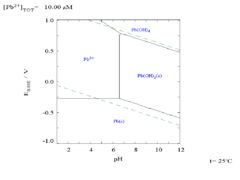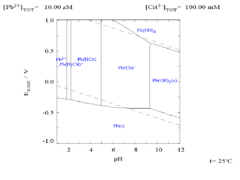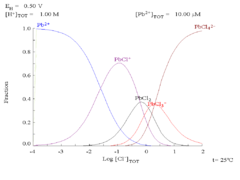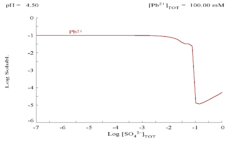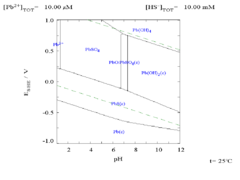Lead
2008/9 Schools Wikipedia Selection. Related subjects: Chemical elements
|
||||||||||||||||||||||||||||||||||||||||||||||||||||||||||||||||||||||||||||||||||||||||||||||||||||||||||||||||||||||||||||||||||||||||||||||||||||||||||
|
|
||||||||||||||||||||||||||||||||||||||||||||||||||||||||||||||||||||||||||||||||||||||||||||||||||||||||||||||||||||||||||||||||||||||||||||||||||||||||||
Lead (pronounced /ˈlɛd/) is a chemical element with the symbol Pb (Latin: plumbum) and atomic number 82. A soft, heavy, toxic and malleable poor metal, lead is bluish white when freshly cut, but tarnishes to dull gray when exposed to air. Lead is used in building construction, lead-acid batteries, bullets and shot, weights, and is part of solder, pewter, and fusible alloys. Lead has the highest atomic number of all stable elements, although the next element, bismuth, has a half-life so long (longer than the estimated age of the universe) it can be considered stable. Like mercury, another heavy metal, lead is a potent neurotoxin that accumulates in soft tissues and bone over time.
Notable characteristics
Lead has a dull luster and is a dense, ductile, very soft, highly malleable, bluish-white metal that has poor electrical conductivity. This true metal is highly resistant to corrosion, and because of this property, it is used to contain corrosive liquids (e.g. sulfuric acid). Lead can be toughened by adding a small amount of antimony or other metals to it. It is a common misconception that lead has a zero Thomson effect. All lead, except 204Pb, is the end product of a complex radioactive decay (see isotopes of lead below). Lead is also poisonous.
History
Lead has been commonly used for thousands of years because it is widespread, easy to extract and easy to work with. It is highly malleable and ductile as well as easy to smelt. In the early Bronze Age, lead was used with antimony and arsenic. Lead was mentioned in the Book of Exodus (15:10). In alchemy, lead was thought to be the oldest metal and was associated with the planet Saturn. Lead pipes that bear the insignia of Roman emperors are still in service and many Roman "pigs" (ingots) of lead figure in Derbyshire lead mining history and in the history of the industry in other English centres. The Romans also used lead in molten form to secure iron pins that held together large limestone blocks in certain monumental buildings. Lead's symbol Pb is an abbreviation of its Latin name plumbum for soft metals; originally it was plumbum nigrum, where plumbum candidum was tin. The English word "plumbing" also derives from this Latin root.
Lead also refers collectively to the organic and inorganic compounds of lead, which are toxic. Lead poisoning was documented in ancient Rome, Greece, and China. In the 20th century, the use of lead in paint pigments was sharply reduced because of the danger of lead poisoning, especially to children. By the mid-1980s, a significant shift in lead end-use patterns had taken place. Much of this shift was a result of the U.S. lead consumers' compliance with environmental regulations that significantly reduced or eliminated the use of lead in non-battery products, including gasoline, paints, solders, and water systems. Lead use is being further curtailed by the European Union's RoHS directive. Lead may still be found in harmful quantities in stoneware, vinyl (such as that used for tubing and the insulation of electrical cords), and brass manufactured in China. Around 2006-2007, many children's toys made in China had been recalled due to lead in paint used to colour the product.
Occurrence
Metallic lead does occur in nature, but it is rare. Lead is usually found in ore with zinc, silver and (most abundantly) copper, and is extracted together with these metals. The main lead mineral is galena (PbS), which contains 86.6% lead. Other common varieties are cerussite (PbCO3) and anglesite (PbSO4).
Lead mining in Wales
Lead ore (galena) is found commonly in northeast Wales. The Northeast Wales Orefield was by far the most important source of lead and zinc in Wales and second in national importance only to the North Pennine Orefield. Lead mining dates back to at least Roman times and continued until well into the 20th century. Galena is present in steeply dipping fissure veins and in pipes and is in Mississippi Valley-type lead-zinc-fluorite and copper-dolomite associations. The mineralisation occurs in the upper parts of the Loggerheads and Cefn Mawr Formations of the Carboniferous Limestone.
Processing of metal from ore
The principal ores of lead are galena (PbS), anglesite (PbSO4) and cerussite (PbCO3). Most ores contain less than 10% lead, and ores containing as little as 3% lead can be economically exploited. Ores are crushed and concentrated by froth flotation typically to 70% or more. Sulfide ores are roasted, producing primarily lead oxide and a mixture of sulfates and silicates of lead and other metals contained in the ore.
Lead oxide from the roasting process is reduced in a coke-fired blast furnace. This converts most of the lead to its metallic form. Three additional layers separate in the process and float to the top of the metallic lead. These are slag (silicates containing 1.5% lead), matte (sulfides containing 15% lead), and speiss (arsenides of iron and copper). These wastes contain concentrations of copper, zinc, cadmium, and bismuth that can be recovered economically, as can their content of unreduced lead.
Metallic lead that results from the roasting and blast furnace processes still contains significant contaminants of arsenic, antimony, bismuth, zinc, copper, silver, and gold. The melt is treated in a reverberatory furnace with air, steam, and sulfur, which oxidizes the contaminants except silver, gold, and bismuth. The oxidized contaminants are removed by drossing, where they float to the top and are skimmed off.
Most lead ores contain significant concentrations of silver, resulting in the smelted metal also containing silver as a contaminant. Metallic silver as well as gold is removed and recovered economically by means of the Parkes process.
Desilvered lead is freed of bismuth according to the Betterton-Kroll process by treating it with metallic calcium and magnesium, which forms a bismuth dross that can be skimmed off.
Very pure lead can be obtained by processing smelted lead electolytically by means of the Betts process. The process uses anodes of impure lead and cathodes of pure lead in an electrolyte of silica fluoride.
Production and Recycling
Worldwide production and consumption of lead is increasing. Total annual production is about 8 million tonnes; about half is produced from recycled scrap. The main countries are Australia, China and the US, which account for more than half of primary production. The most common lead ore is galena or lead sulfide.
- Annual Metal Production (2006): 7918 Thousand tonnes
- Annual Mine Production (2006): 3442 Thousand tonnes (lead content)
At current use rates, the supply of lead is estimated to run out in 42 years. Environmental analyst, Lester Brown, however, has suggested lead could run out within 18 years based on a reasonable extrapolation of 2% growth per year.
Isotopes
Lead has four stable isotopes - 204Pb, 206Pb, 207Pb, 208Pb and one common radiogenic isotope 202Pb with a half-life of ~53,000 years.
Health effects
Lead is a poisonous metal that can damage nervous connections (especially in young children) and cause blood and brain disorders. Long term exposure to lead or its salts (especially soluble salts or the strong oxidant PbO2) can cause nephropathy, and colic-like abdominal pains. The concern about lead's role in cognitive deficits in children has brought about widespread reduction in its use (lead exposure has been linked to schizophrenia). Most cases of adult elevated blood lead levels are workplace-related. High blood levels are associated with delayed puberty in girls.
Older houses may still contain substantial amounts of lead paint. White lead paint has been withdrawn from sale in industrialized countries, but the yellow lead chromate is still in use; for example, Holland Colours Holcolan Yellow. Old paint should not be stripped by sanding, as this produces inhalable dust.
Lead salts used in pottery glazes have on occasion caused poisoning, when acid drinks, such as fruit juices, have leached lead ions out of the glaze. It has been suggested that what was known as " Devon colic" arose from the use of lead-lined presses to extract apple juice in the manufacture of cider. Lead is considered to be particularly harmful for women's ability to reproduce. For that reason, many universities do not hand out lead-containing samples to women for instructional laboratory analyses. Lead acetate (also known as sugar of lead) was used by the Roman Empire as a sweetener for wine, and some consider this to be the cause of the dementia that affected many of the Roman Emperors.
Lead as a soil contaminant is a widespread issue, since lead is present in natural deposits and may also enter soil through (leaded) gasoline leaks from underground storage tanks or through a wastestream of lead paint or lead grindings from certain industrial operations.
Biochemistry of lead poisoning
In medicine, lead inhibits α-aminolevulinate ( ALA) dehydratase and ferrochelatase, preventing both porphobilinogen formation and the incorporation of iron into protoporphyrin IX, the final step in heme synthesis. This causes ineffective heme synthesis and subsequent microcytic anaemia.
Leaching of lead from metal surfaces
It is clear from the Pourbaix diagram below that lead is more likely to corrode in a citrate medium than it is in a non-complexing medium. The central part of the diagram shows that lead metal is more easy to oxidise in the citrate medium than it is in normal water.
In a Pourbaix diagram, the acidity is plotted on the x axis using the pH scale, while how oxidising/reducing nature of the system is plotted on the y axis in terms of volts relative to the standard hydrogen electrode. The diagram shows the form of the element which is most chemically stable at each point, it only comments on thermodynamics and it says nothing about the rate of change ( kinetics).
Descriptive chemistry
Various oxidized forms of lead are easily reduced to the metal. An example is heating PbO with mild organic reducing agents such as glucose. A mixture of the oxide and the sulfide heated together without any reducing agent will also form the metal.
-
- 2PbO + PbS → 3 Pb + SO2
Metallic lead is attacked only superficially by air, forming a thin layer of oxide that protects it from further oxidation. The metal is not attacked by sulfuric or hydrochloric acids. It does, however, dissolve in nitric acid with the evolution of nitric oxide gas to form dissolved Pb(NO3)2.
-
- 3 Pb + 8 H+ + 8 NO3– → 3 Pb2+ + 6 NO3– + 2 NO + 4H2O
When heated with nitrates of alkali metals, metallic lead oxidizes to form PbO (also known as litharge), leaving the corresponding alkali nitrite. PbO is representative of lead's II oxidation state. It is soluble in nitric and acetic acids, from which solutions it is possible to precipitate halide, sulfate, chromate, carbonate (PbCO3), and basic carbonate (Pb3(OH)2(CO3)2) salts of lead. The sulfide can also be precipitated from acetate solutions. These salts are all poorly soluble in water. Among the halides, the iodide is less soluble than the bromide, which, in turn, is less soluble than the chloride.
The II oxide is also soluble in alkali hydroxide solutions to form the corresponding plumbite salt.
-
- PbO + 2OH– + H2O → Pb(OH)42–
Chlorination of plumbite solutions causes the formation of lead's IV oxidation state.
-
- Pb(OH)42– + Cl2 → PbO2 + 2 Cl– + 2 H2O
Lead dioxide is representative of the IV state, and is a powerful oxidizing agent. The chloride of this oxidation state is formed only with difficulty and decomposes readily into the II chloride and chlorine gas. The bromide and iodide of IV lead are not known to exist. Lead dioxide dissolves in alkali hydroxide solutions to form the corresponding plumbates.
-
- PbO2 + 2 OH– + 2 H2O → Pb(OH)62–
Lead also has an oxide that is a hybrid between the II and IV oxidation states. Red lead (also called minium) is Pb3O4.
Lead readily forms an equimolar alloy with sodium metal that reacts with alkyl halides to form organometallic compounds of lead such as tetraethyl lead.
Chloride complexes
Lead(II) forms a series of complexes with chloride, the formation of which alters the corrosion chemistry of the lead. This will tend to limit the solubility of lead in saline media.
-
Equilibrium constants for aqueous lead chloride complexes at 25 °C Pb2+ + Cl– → PbCl+ K1 = 12.59 PbCl+ + Cl− → PbCl20 K2 = 14.45 PbCl20 + Cl− → PbCl3− K3 = 3.98 ×10−1 PbCl3− + Cl− → PbCl42− K4 = 8.92 × 10−2
Phase diagrams of solubilities
Lead(II) sulfate is poorly soluble, as can be seen in the following diagram showing addition of SO42− to a solution containing 0.1M of Pb2+. The pH of the solution is 4.5, as above that, Pb2+ concentration can never reach 0.1M due to the formation of Pb(OH)2. Observe that Pb2+ solubility drops 10,000 fold as SO42− reaches 0.1M
Here it can be seen that the addition of chloride can lower the solubility of lead, however in chloride rich media (such as aqua regia) the lead can become soluble again as anionic chlorocomplexes.
The Pourbaix diagram on the right is for a moderate concentration (0.1 M) of chloride.
Applications
- Lead is a major constituent of the lead-acid battery used extensively in car batteries.
- Lead is used as a coloring element in ceramic glazes, notably in the colors red and yellow.
- Lead is used to form glazing bars for stained glass or other multi-lit windows. The practice has become less common, not for danger but for stylistic reasons.
- Lead is used as projectiles for firearms and fishing sinkers because of its density, low cost compared to alternative products and ease of use due to relatively low melting point.
- Lead or "sheet-lead" is used as a sound deadening layer in such areas as wall, floor and ceiling design in sound studios where levels of airborne and mechanically produced sound are targeted for reduction or virtual elimination.
- Lead is used in some candles to treat the wick to ensure a longer, more even burn. Because of the dangers, European and North American manufacturers use more expensive alternatives such as zinc.
- Lead is used as shielding from radiation.
- Molten lead is used as a coolant, eg. for lead cooled fast reactors.
- Lead glass is composed of 12-28% lead oxide. It changes the optical characteristics of the glass and reduces the transmission of radiation.
- Lead is the traditional base metal of organ pipes, mixed with varying amounts of tin to control the tone of the pipe.
- Lead is used as electrodes in the process of electrolysis.
- Lead is used in solder for electronics, although this usage is being phased out by some countries to reduce the amount of environmentally unfriendly waste.
- Lead is used in high voltage power cables as sheathing material to prevent water diffusion into insulation.
- Lead is used for the ballast keel of sailboats. Its high weight-to-volume ratio allows it to counterbalance the heeling effect of wind on the sails while at the same time occupying a small volume and thus offering the least underwater resistance.
- Lead is added to brass to reduce machine tool wear.
- Lead sheets are used as roofing material.
- Lead is frequently used in scuba diving weight belts to counteract the diver's natural buoyancy and that of his equipment.
- Lead is often used to balance the wheels of a car; this use is being phased out in favour of other materials for environmental reasons.
- Lead is still widely used in statues and sculptures.
Former applications
- Lead was used as a pigment in lead paint for white as well as yellow and red colors. It was discontinued because of the dangers of lead poisoning. However, lead chromate is still in use.
- Lead was the hot metal used in hot metal typesetting.
- Lead was used for plumbing in Ancient Rome.
- Lead was used as a preservative for food and drink in Ancient Rome.
- Lead was used for joining cast iron water pipes and used as a material for small diameter water pipes until the early 1970s.
- Tetraethyl lead was used in leaded fuels to reduce engine knocking; however, this is no longer common practice in the Western world due to health concerns.
- Lead was used to make bullets for slings.
- Lead was used as a component of toys. Due to toy safety regulations, this use has been stopped in the United States.
- Lead was used in car body filler, which was used in many custom cars in the 1940s–60s. Hence the term Leadsled.
- Lead is a superconductor at 7.2 K and IBM tried to make a Josephson Effect Computer out of lead-alloy.
Contrary to popular belief, pencil "leads" have never been made from lead. The term comes from the Roman stylus, called the penicillus, which was made of lead. When the pencil originated as a wrapped graphite writing tool, the particular type of graphite being used was named plumbago (lit. "act for lead"; "leadmocku").
Phrases
A "lead pipe cinch" is something that is absolutely certain. In the 19th century, a horse saddle was safe when it was well "cinched". The "lead pipe" qualifier is an obscure "intensifier".
A "lead pencil" is a leftover term from when the original pencils were made from the only known deposit of graphite ever to be found in a pure, solid state, in 16th century England. The new material was assumed to be a form of lead. Modern pencils use a marking core made of powdered, refined graphite mixed with clay, as has been the practice for centuries.




